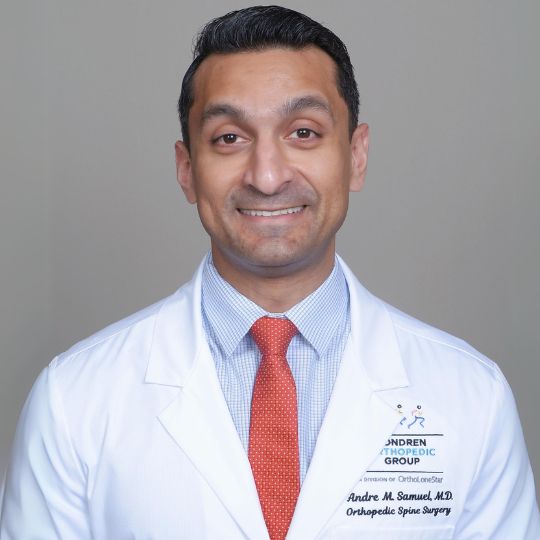TLIF Surgeon
Transforaminal Lumbar Interbody Fusion (TLIF) is a good option for those experiencing chronic lower back pain that has not responded to conservative treatments like physical therapy or injections. Doctor Andre M. Samuel, orthopedic spine surgeon in Clear Lake, Houston and Sugar Land, TX, offers minimally invasive transforaminal interbody fusion surgery for a faster recovery and lasting relief from back pain. Schedule your consultation today!

What is a transforaminal lumbar interbody fusion?
A transforaminal lumbar interbody fusion (TLIF) is lower back surgery to join, or fuse, two unstable bones (vertebrae) in the back together. During the procedure, part of the disc between the bones is removed and replaced with a spacer (cage). Screws, rods, and bone graft are used to provide stability and allow the bone to grow together. Using a spacer also increases the height of a collapsed disc, relieving pressure on compressed nerves, helping to alleviate pain. It’s a popular choice because it does not require additional incisions in the belly or side to insert a spacer. Only one or two incision are made directly in the back. Doctor Andre M. Samuel, orthopedic spine surgeon, treats patients in the Clear Lake, Houston, Sugar Land, TX area who may need a transforaminal lumbar interbody fusion.

What is a minimally invasive TLIF?
Dr. Samuel prefers minimally invasive TLIF over traditional open surgery because it causes less muscle disruption, involves smaller incisions, and results in reduced pain. Patients enjoy quicker recovery times and get back to their daily activities faster. Plus, this technique which sometimes uses expandable cage technology, offers more precision and better support. In some cases, this method can be performed on an outpatient basis, allowing patients to return home the same day.
Who is a candidate for transforaminal lumbar interbody fusion?
Transforaminal Lumbar Interbody Fusion (TLIF) is a good option for those experiencing chronic lower back pain that has not responded to conservative treatments like physical therapy or injections. Dr. Samuel often recommends the procedure for patients with conditions such as degenerative disc disease, spondylolisthesis (instability between bones), spinal stenosis, or herniated discs. Minimally invasive TLIF is also a good fit for those needing spinal stabilization due to fractures or spinal deformities. Ideal candidates are those in good overall health who can tolerate the surgery and rehab process. The decision to have surgery is always up to the patient. Dr. Samuel and his team are always available to answer questions.
How is a transforaminal lumbar interbody fusion performed?
The patient is placed under general anesthesia and then Dr. Samuel makes a small incision on one side of the back. He then moves muscles and tissues aside revealing the problem area.
The damaged or degenerated disc is removed to relieve nerve pressure and make room for the fusion. A spacer filled with bone graft material from the patient (autograft) or a donor (allograft) is inserted into the empty disc space to encourage the vertebrae to fuse. In some cases, a bone morphogenetic protein (BMP), which occurs naturally in the body is used to stimulate bone growth. Screws and rods are also used to help to stabilize the area.
Sometimes Dr. Samuel uses expandable cage technology for better alignment. This helps maintain the proper height between vertebrae. Once everything is in place, the muscles and ligaments are moved back and the incision is closed. The patient is monitored in recovery for any complications before being allowed to return home.
How long does it take to recover from a transforaminal interbody fusion?
After minimally invasive TLIF surgery, patients usually have some soreness in the lower back, but this subsides within four to six weeks. While it typically takes 3 to 6 months to recover fully, many patients are off pain medicines and back to work within two weeks. Walking is encouraged the same day as surgery, and physical therapy is often recommended to help strengthen the back and support a smooth recovery. Patients should avoid any heavy lifting or strenuous activity during the recovery period. Also, Follow-up visits with Dr. Samuel are crucial to make sure the spine is healing properly.



